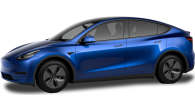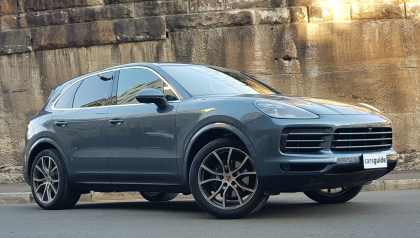Maserati. What do you reckon that name means to most people? Fast? Loud? Italian? Expensive? SUVs?
Well, maybe not the last one, but it likely will soon. See, with the Levante SUV accounting for half of all Maseratis now sold in Australia, shortly it’ll feel like SUVs are all Maserati makes.
And that may happen even faster with the arrival of the most affordable Levante ever - the new entry-grade, simply called Levante.
So, if this new cheaper Levante isn’t expensive (in Maserati terms) does that mean it’s not fast, loud or even Italian, now?
We drove this new, most affordable, Levante at its Australian launch to find out.
Maserati Levante 2019: Gransport
| Engine Type | Diesel Turbo V6, 3.0L |
|---|---|
| Fuel Type | Diesel |
| Fuel Efficiency | 11.8L/100km (combined) |
| Seating | 5 |
| Price From | $97,900 - $112,530 |
Does it represent good value for the price? What features does it come with?
7 / 10
Guessing you want to know just how much more affordable this Levante is compared to the other grades in the range? Okay, the entry-level Levante lists for $125,000, before on-road costs.
That may sound expensive but look at it like this: the entry Levante has the same Maserati-designed and Ferrari-made 3.0-litre twin-turbo petrol V6 as the $179,990 Levante S and an almost identical standard features list.
So how on this planet is it possible there could be a $55K price difference and yet the cars be almost the same? What’s missing?

Horsepower is missing – the base grade Levante may have the same V6 as the Levante S but it doesn’t have as much grunt. But we’ll get to that in the engine section.
As for the other differences – there aren’t many, almost none. The Levante S comes with a sunroof as standard and front seats that adjust to more positions than the Levante, but both grades come with an 8.4-inch touchscreen with Apple CarPlay and Android Auto, sat nav, leather upholstery (the S does get more premium leather), a proximity key and 19-inch alloy wheels.
Those standard features are also identical to those in the Turbo-Diesel which sits above the Levante at $159,990.
Apart from less horsepower, no standard sunroof (as on the S) and upholstery which isn’t quite as nice as the S’s another downside to the base grade Levante is that optioning the GranLusso and GranSport packs is expensive… really expensive.

The GranLusso adds luxurious touches to the exterior in the form of metallic trim to the roof rails, the window frames and protection plates to the front bumper, while in the cabin thee front seats come in a choice of Ermenegildo Zegna silk upholstery, Pieno Fiore (full-grain) leather or premium Italian hide.
The GranSport toughens up the exterior with a more aggressive body kit with black elements and adds 12-way power adjustable sports seats, brushed-chrome shifting paddles and aluminium-face sports pedals.
The features those packages offer are nice – those silk and leather seats are sumptuous for example, but each pack costs $35,000. That’s almost 30 per cent of the list price of the entire vehicle, extra. The same packages on the Levante S costs just $10,000.
While the Levante is the most affordable Levante, and also the cheapest Maserati you can buy, it’s more expensive than its Porsche Cayenne (entry V6 petrol) rival which lists for $116,000, while the Range Rover Sport 3.0 SC HSE is $130,000 and the Mercedes-Benz GLE 43 is $135,529.
Is the new entry-grade Levante good value, then? Yes, for a Maserati, if you don’t option the packages, and yes compared to most of its rivals.
What are the key stats for the engine and transmission?
8 / 10
If you’ve just read the section above on price and features, you’re now probably wondering how much less powerful the Levante is compared to the Levante S.
The Levante has a 3.0-litre twin-turbo petrol V6 and it sounds magnificent. Yup, the entry-grade Levante lets loose that Maserati high-pitched scream when you open the throttle, just like the S. It may sound the same as the S but the Levante’s V6 has less horsepower. At 257kW/500Nm, the Levante makes 59kW less in power and 80Nm less in torque.

Is there a noticeable difference? Not much. Acceleration isn’t as rapid in the Levante with 0-100km/h coming in six seconds compared to 5.2 seconds in the Levante S.
Shifting gears is an eight-speed ZF-sorced automatic transmission which is super smooth, but a little slow.
Is there anything interesting about its design?
7 / 10
The Levante looks exactly how a Maserati SUV should, with the long bonnet flanked by curvaceous wheel arches with their vents, leading towards a grille that looks ready to eat up slower cars. The heavily raked windscreen and cab-back profile is also very Maserati, as are haunches that muscle over the rear wheels.
If only its bottom was less Maserati. It’s a personal thing, but I find Maserati rear ends lack the drama of their faces and the Levante’s tailgate is no different in that it borders on plain.
Inside, the Levante looks to be a premium, well-crafted place, although closer inspection reveals there are certain items which appear to be shared with other brands which, like Maserati, are owned by Fiat Chrysler Automobiles (FCA).
The window and headlight switches, the ignition button, the air-conditioning controls, even the display screen all can be found in Jeeps and other FCA cars.
There are no functionality issues here, but from a design and style perspective they look a little basic and lack the refinement a buyer may expect from a Maserati.
There’s a lack of technological pizazz inside as well. For example, there’s no head-up display or large virtual instrument cluster as you’ll find in the Levante’s competitors.
Despite the Jeep-looking bits the Levante is truly Italian. The chief designer Giovanni Ribotta is Italian and the Levante is made at FCA's Mirafiori plant in Turin.
What are the Levante’s dimensions? The Levante is 5.0m long, 2.0m wide and 1.7m tall. So that means space inside is enormous right? Um… let’s talk about that in the next section, shall we?
How practical is the space inside?
7 / 10
You know the Tardis from Dr Who? The time machine police phone box that is much bigger on the inside than it appears from the outside? The Levante’s cabin is a reverse Tardis (a Sidrat?) in that even at five metres long and two metres wide, legroom in the second row is tight and at 191cm tall I can only just sit behind my driving position.
Headroom is also getting tight back there because of the swooping roofline. These aren’t major issues, but If you were thinking of using the Levante as a SUV limousine of sorts then the limited room back there just won’t be enough to let your taller passengers stretch out comfortably.
Also ruling it out as a chauffeur car in my view is the ride experience in the second row. I’ll cover this in the driving section below.
The Levante’s cargo capacity is 580 litres (with second row seats up) which is on the small side, and less than the Porsche Cayenne’s 770 litre boot space.
Cabin storage is pretty good, with a giant centre console bin up front with two cupholders inside. There are another two cupholders near the shifter and two more in the fold-down armrest in the rear. Door pockets are on the smaller side, however.
How much fuel does it consume?
7 / 10
Even if you were to drive your Levante conservatively Maserati says you can expect it to use at best 11.6L/100km over a combination of urban and open roads, the Levante S is a bit thirstier at an official 11.8L/100km.
In reality you can expect the twin-turbo petrol V6 to want more – just open road driving was seeing the trip computer report 12.3L/100km, You can bet that’ll go up in the city and climb higher if you like to keep raising the Levante's beautiful voice.
Warranty & Safety Rating
What safety equipment is fitted? What safety rating?
8 / 10
The Levante is yet to be tested by ANCAP. That said, the Levante has six airbags and is equipped with advanced safety equipment such as AEB, lane keeping assistance and lane departure warning, blind spot warning with steering assistance, traffic sign recognition and adaptive cruise control.
A puncture repair kit is under the boot floor.
What does it cost to own? What warranty is offered?
6 / 10
The Levante is covered by Maserati’s three year/unlimited kilometre warranty. Servicing is recommended at two year or 20,000km intervals. More brands are moving to longer warranties and it would be good to see Maserati offer its buyers longer coverage.
What's it like to drive?
8 / 10
When I reviewed the Levante S at its launch in 2017 I enjoyed its good handling and comfortable ride. But impressed as I was with performance from the engine I felt the car could be quicker.
So how then would a less powerful version of the same car feel? Not much different, actually. The base grade Levante is only 0.8s slower to 100km/h than the S at six seconds. The air suspension is the same as the S’s and returns a comfortable and compliant ride, and handling with the dampers in the firm setting is impressive for a two tonne, five-metre long vehicle.

Front brakes in the Levante base grade car are smaller (345 x 32mm) than in the S (380 x 34mm) and the tyres aren’t staggered either with 265/50 R19 all around.
The variable-ratio, electrically-assisted power steering is well weighted, but too quick. I found the car turned in too far, too quickly, with regular mid-corner corrections a tiresome necessity.
To me there’s no point going for the S based on the assumption that it’s going to be a much higher performing car. The Levante and Levante S and are both mild in their power delivery and have better dynamics than an average large SUV.
If you are after a true high-performance Maserati SUV then you might be best off waiting for the Levante GTS coming in 2020 with a 404kW V8.

The base grade Levante V6 sounds just as beautiful as the S’s, but there's one place where it isn’t very pleasant. The back seat.
At the launch of the Levante S in 2017 I didn’t have the chance to ride in the rear seats. This time around I let my co-driver steer for half-an-hour while I sat in the left rear position.
For starters it’s louder back there – the exhaust note is almost too loud to be pleasant. Plus, the seats aren’t supportive or comfortable.
There’s also a slightly claustrophobic, cave-like feeling in the second row, largely due to the roof's accentuated slope towards the rear. This, to me, rules it out almost completely as something to ferry guests around in comfort.
Verdict
The entry-grade Levante is the best choice in the current line-up (Levante, Levante Turbo Diesel and Levante S) because it’s almost identical in performance and features to the pricier S.
I’d give the GranLusso and GranSport packs a miss on this base Levante, but would consider them on the S where they are possibly worth the extra $10,000 rather than the $35K asking price on the entry car.
The Levante does a lot right – the sound, the safety and the exterior styling. But the quality of the interior, with its FCA shared parts, lowers what should be a prestige feel.
And back seat comfort could be better, Maseratis are grand tourers and an SUV from this brand should be able to accommodate at least four adults in superb comfort – something this one can’t do.





























.jpg)
.jpg)




